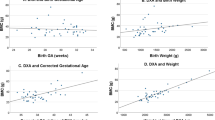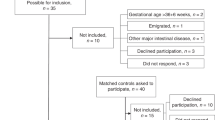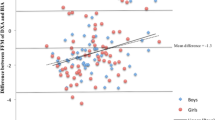Abstract
OBJECTIVE: Quantitative ultrasound is increasingly used to assess bone status in adults and children; however, few studies have been carried out in neonates. Our objective was to determine if tibial bone speed of sound (SOS) correlates with gestational age and birth anthropometrics, and if bone SOS is related to maternal factors.
STUDY DESIGN: We prospectively studied 95 preterm infants to assess factors related to bone status as measured by quantitative ultrasound.
RESULTS: We found significant (p≤0.001) positive correlations between SOS and gestational age, birth weight, length, head circumference and tibial length. There was no significant relationship between SOS and prenatal steroid use, gestational diabetes, pre-eclampsia, race or parity.
CONCLUSIONS: Quantitative ultrasound is an easy to use and inexpensive tool for assessing bone status in preterm neonates. Tibial SOS correlated with gestational age and birth anthropometrics, and was not related by few maternal factors.
This is a preview of subscription content, access via your institution
Access options
Subscribe to this journal
Receive 12 print issues and online access
$259.00 per year
only $21.58 per issue
Buy this article
- Purchase on Springer Link
- Instant access to full article PDF
Prices may be subject to local taxes which are calculated during checkout

Similar content being viewed by others
References
Taeusch W, Ballard R, Avery's Disease of the NewBorn, 7th edn. London: WB Saunders Company; 1998. p. 970–973.
Backstrom MC, Kuusela AL, Maki R . Metabolic bone disease of prematurity. Ann Med 1996;28:275–282.
Prins SH, Jorgensen HL, Jorgensen LV, Hassager C . The role of quantitative ultrasound in the assessment of bone: a review. Clin Physiol 1998;18:3–17.
Njeh CF, Fuerst T, Diessel E, Genant HK . Is quantitative ultrasound dependent on bone structure? A reflection. Osteoporos Int 2001;12:1–15.
Ng DC, Sundram FX . Bone mineral density — correlation between quantitative ultrasound characteristics and dual energy X-ray absorptiometry. Ann Acad Med Singapore 1998;27:524–526.
Van Rijn RR, van der Sluis IM, Lequin MH, et al. Tibial quantitative ultrasound versus whole body and lumber spine DXA in a Dutch pediatric and adolescent population. Invest Radiol 2000;35:548–552.
Sundberg M, Gardsell P, Johnell O, Ornstein E, Sernbo I . Comparison of quantitative ultrasound measurements in calcaneus with DXA and SXA at other skeletal sites: a population-based study on 280 children aged 11–16 years. Osteoporos Int 1998;8:410–417.
Jaworski M, Lebiedowski M, Lorenc RS, Trempe J . Ultrasound bone measurement in pediatric subjects. Calcif Tissue Int 1995;56:368–371.
Lappe JM, Stegman M, Davies KM, Barber S, Recker RR . A prospective study of quantitative ultrasound in children and adolescents. J Clin Densitom 2000;3:167–175.
Prevrhal S, Fuerst T, Fan B, et al. Quantitative ultrasound of the tibia depends on both cortical density and thickness. Osteoporos Int 2001;12:28–34.
Lequin MH, Hop WC, Van Rijn RR, et al. Comparison between quantitative calcaneal and tibial ultrasound in a Dutch Caucasian pediatric and adolescent population. J Clin Densitom 2001;4:137–146.
Lequin MH, Van Rijn RR, Robben SG, Hop WC, Van Kuij KC . Normal values for tibial quantitative ultrasonometry in Caucasian children and adolescents (aged 6–19 years). Calcif Tissue Int 2000;67:101–105.
Nemet D, Dolfin T, Wolach B, Eliakim A . Quantitative ultrasound measurements of bone speed of sound in premature infants. Eur J Pediatr 2001;160:736–740.
Littner Y, Mandel D, Mimouni FB, Dollberg S . Bone ultrasound velocity curves of newly born term and preterm infants. J Pediatr Endocrinol Metab 2003;16:43–47.
Cummins SR, Bates D, Black DM . Clinical use of Bone Densitometry. JAMA 2002;288:1889–1896.
Holm K, Dan A, Wilbur J, Li S, Walker J . A longitudinal study of bone density in midlife women. Health Care Women Int 2002;23:678–691.
Koo WW, Hockman EM . Physiologic predictors of lumbar spine bone mass in neonates. Ped Res 2000;48:485–489.
Medras M, Jankowska EA, Rogucka E . The effect of smoking tobacco and drinking of alcohol and coffee on bone mineral density of healthy men 40 years of age. Pol Arch Med Wewn 2000;103:187–193.
Nociti Jr FH, Cesar NJ, Carvalho MD, Sallum EA . Bone density around titanium implants may be influenced by intermittent cigarette smoke inhalation: a histometric study in rats. Int J Oral Maxillofac Implants 2002;17:347–352.
Blum M, Harris SS, Must A, Phillips SM, Rand WM, Dawson-Hughes B . Household tobacco exposure in negatively associated with premenopausal bone mass. Osteoporos Int 2002;13:663–668.
Ueng SW, Lee SS, Lin SS, et al. Hyperbaric oxygen therapy mitigates the adverse effect of cigarette smoking on the bone healing of tibial lengthening: an experimental study on rabbits. J Trauma 1999;47:752–759.
Ueng SW, Lin SS, Wang CR, Liu SJ, Tai CL, Shih CH . Bone healing of tibial lengthening is delayed by cigarette smoking: study of bone mineral density and torsional strength on rabbits. J Trauma 1999;46:110–115.
Iwaniec UT, Fung YK, Cullen DM, Akhter MP, et al. Effects of nicotine on bone and calciotropic hormones in growing female rats. Calcif Tissue Int 2000;67:68–74.
Iwaniec UT, Fung YK, Akhter MP, et al. Effects of nicotine on bone mass, turnover, and strength in adult female rats. Calcif Tissue Int Int 2001;68:358–364.
Syversen U, Nordsletten L, Falch JA, Madsen JE, Nilsen OG, Waldum HL . Effect of lifelong nicotine inhalation on bone mass and mechanical properties in female rat femurs. Calcif Tissue Int 1999;65:246–249.
Kesiak M, Gulczynska E, Nowakowska D, Wilczynski J . Influence of antenatal steroid therapy on newborn nervous system. Ginekol Pol 2002;73:709–718.
McEvoy C, Bowling S, Williamson K, Stewart M, Durand M . Functional residual capacity and passive compliance measurements after antenatal steroid therapy in preterm infants. Pediatr Pulmonol 2001;31:425–430.
Cattarelli D, Chirico G, Simeoni U . Renal effects of antenatally or postnatally administered steroids. Pediatr Med Chir 2002;24:157–162.
AAP Committee on Fetus and Newborn Postnatal Corticosteroids to treat or prevent chronic lung disease in preterm infants. Pediatrics 2002;109:330–338.
Bloom SL, Sheffield JS, Mc Intire DD, Leveno KJ . Antenatal dexamethasone and decreased birth weight. Obstet Gynecol 2001;97:485–490.
Sonntag J, Gaude M . Effect of dexamethasone and spironolactone therapy in calcium and phosphate homeostasis in premature infants with a birth weight under 1.500 g. Klin Padiatr 1998;210:354–357.
Kurl S, Heinonen K, Lansimies E . Effects of prematurity, intrauterine growth status and early dexamethasone treatment on postnatal bone mineralization. Arch Dis Child Fetal Neonatal Ed 2000;83:109–111.
Lopez Ibarra PJ, Pastor MM, Escobar-Jimenez F, et al. Bone mineral density at time of clinical diagnostic of adult-onset type 1 diabetes mellitus. Endocr Pract 2001;7:346–351.
Espallargues M, Sampietro-Colom Estrada MD, Sola M, del Rio L, Setoain J, Granados A . Identifying bone-mass-related risk factors for fracture to guide bone densitometry measurements: a systematic review of the literature. Osteoporosis Int 2000;12:811–822.
Gunczler P, Lanes R, Paz-Martinez V, et al. Decreased lumbar spine bone mass and low bone turnover in children and adolescents with insulin dependent diabetes mellitus followed longitudinally. J Pediatric Endocrinol Metab 1998;11:413–419.
Mimouni F, Steichen JJ, Tsang RC, Hertzberg V, Miodovnik M . Decreased bone mineral content in infants of diabetic mothers. Am J Perinatol 1988;5:339–343.
Lequin MH, Van Rijn RR, Robben SG, et al. Evaluation of short-term precision for tibial ultrasonometry. Calcif Tissue Int 1999;64:24–27.
Litmanovitz I, Dolfin T, Friedland O, et al. Early physical activity intervention prevents decrease of bone strength in very low birth weight infants. Pediatrics 2003;112:15–19.
Eliakim A, Nemet D, Friedland O, Dolfin T, Regev R . Spontaneous activity in premature infants affects bone strength. J Perinatol 2002;22:650–652.
Acknowledgements
We acknowledge the kind assistance and editorial review by Dr Lewis Barness. We express our great appreciation for the help and enthusiastic support of the nursing staff of Tampa General Hospital NICU.
Author information
Authors and Affiliations
Additional information
Supported in part by Sunlight Medical, Ltd
Rights and permissions
About this article
Cite this article
Pereda, L., Ashmeade, T., Zaritt, J. et al. The Use of Quantitative Ultrasound in Assessing Bone Status in Newborn Preterm Infants. J Perinatol 23, 655–659 (2003). https://doi.org/10.1038/sj.jp.7211006
Published:
Issue Date:
DOI: https://doi.org/10.1038/sj.jp.7211006
This article is cited by
-
Feasibility of quantitative ultrasonography for the detection of metabolic bone disease in preterm infants — systematic review
Pediatric Radiology (2018)
-
High Beta-Palmitate Formula and Bone Strength in Term Infants: A Randomized, Double-Blind, Controlled Trial
Calcified Tissue International (2013)
-
Ultrasound for the assessment of bone quality in preterm and term infants
Journal of Perinatology (2012)
-
Bone ultrasound velocity in small- versus appropriate-for-gestational age preterm infants
Journal of Perinatology (2007)
-
Bone measurements of infants in the first 3 months of life by quantitative ultrasound: the influence of gestational age, season, and postnatal age
Pediatric Radiology (2005)



